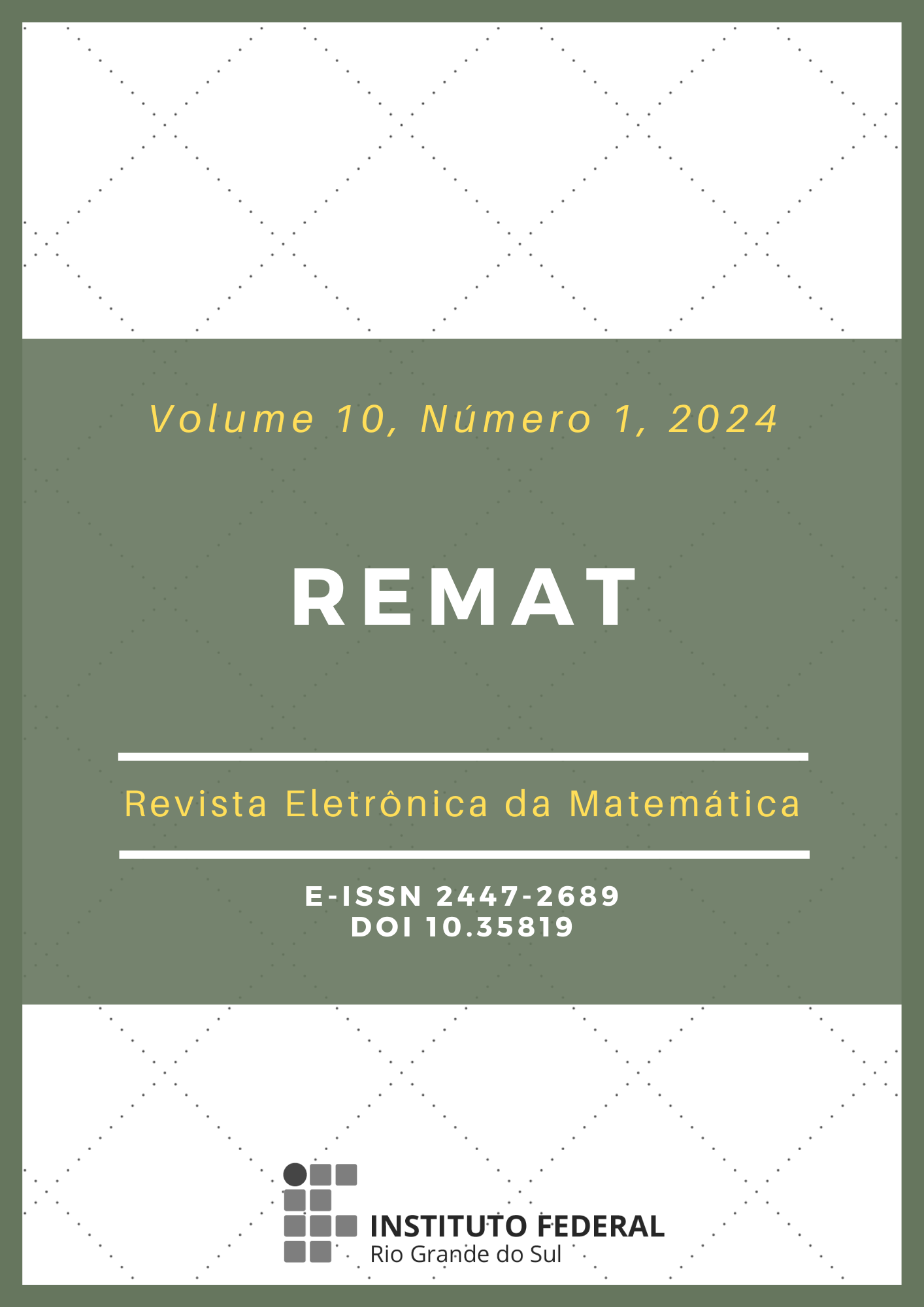Nuances of theoretical and numerical aspects of the fully developed flow in a pipe
DOI:
https://doi.org/10.35819/remat2024v10i1id6667Keywords:
finite differences, circular geometry, iterative methods, Poisson equation, analytical solutionAbstract
The fully developed flow of a Newtonian fluid in a circular cross-section tube will be applied to discussions of theoretical solutions and numerical methodologies, based on the finite difference technique. The objective is to present details of obtaining the analytical solution, the numerical methodologies used and the physics involved, in order to disseminate an original didactic-scientific compilation in this area. The flow in deal is modeled by an elliptic partial differential equation subject to a Dirichlet condition at the boundary. The boundary of the tube does not coincide with the computational mesh which is uniform rectangular. Therefore, a linear extrapolation technique will be employed. The resulting linear system is solved by classical Jacobi and Gauss-Seidel methods for comparison. A mesh refinement process demonstrates that the numerical solution converges to the analytical solution with order O(h^3). The relationship between the number of iterations of the Jacobi and Gauss-Seidel methods and the condition number of the matrix of the linear system corroborates that the Jacobi method requires approximately twice as many iterations as the Gauss-Seidel method to converge. Results about the influence of the physical parameters of the model and the relationship between average and maximum velocities are investigated. It is shown, analytically, that the absolute value of the pressure gradient is directly proportional to the velocity, while the characteristics are inversely proportional to this variable, furthermore, the proportionality relationship between the average and maximum flow velocities is theoretically demonstrated and applied for other numerical verifications.
Downloads
References
AFTOSMIS, M. J.; BERGER, M. J. ; MELTON, J. E. Robust and efficient Cartesian mesh generation for component-based geometry. AIAA Journal, v. 36, n. 6, p. 952-960, 1998. DOI: https://doi.org/10.2514/2.464.
BURDEN, R. L.; FAIRES, D. J.; BURDEN, A. M. Análise Numérica. 3. ed. São Paulo: Cengage, Leaning, 2015.
COLNAGO, M.; CASACA, W.; SOUZA, L. F. de. A high-order immersed interface method free of derivative jump conditions for Poisson equations on irregular domains. Journal of Computational Physics, v. 423, 2020. DOI: https://ui.adsabs.harvard.edu/link_gateway/2020JCoPh.42309791C/doi:10.1016/j.jcp.2020.109791.
CUMINATO, J. A.; MENEGUETTE JUNIOR, M. Discretização de equações diferenciais parciais: técnicas de diferenças finitas. Coleção Matemática Aplicada. Rio de Janeiro: SBM, 2013.
EVANS, Lawrence C. Partial differential equations. Graduate Studies in Mathematics. v. 19. Providence, Rhode Island: American Mathematical Society, 1998.
FEDKIW, R. P.; ASLAM, T.; MERRIMAN, B.; OSHER, S. A non-oscillatory Eulerian approach to interfaces in multimaterial flows (the ghost fluid method). Journal of Computational Physics, v. 152, n. 2, p. 457-492, 1999.
FRANCO, N. M. B. Cálculo Numérico. 1. ed. São Paulo: Pearson Prentice Hall, 2006.
GOLUB , G. H.; VAN LOAN, C. F. Matrix Computations. 3. ed. London: Johns Hopkins University Press, 1996.
JOMAA, Z.; MACASKILL, C. The embedded finite difference method for the Poisson equation in a domain with an irregular boundary and Dirichlet boundary conditions. Journal of Computational Physics, v. 202, n. 2, p. 488-506, 2005. DOI: https://doi.org/10.1016/j.jcp.2004.07.011.
LEVEQUE, R. J. Finite difference methods for ordinary and partial differential equations: steady-state and time-dependent problems. Philadelphia: SIAM, 2007.
LEVEQUE, R. J.; LI, Z. The immersed interface method for elliptic equations with discontinuous coefficients and singular sources. SIAM Journal on Numerical Analysis, v. 31, n. 4, p. 1019-1044, 1994. Disponível em: https://www.jstor.org/stable/2158113. Acesso em: 16 mar. 2024.
LI, Z. A note on immersed interface method for three-dimensional elliptic equations. Computers & Mathematics with Applications, v. 31, n. 3, p. 9-17, 1996. DOI: https://doi.org/10.1016/0898-1221(95)00202-2.
LI, Z.; ITO, K. The immersed interface method: numerical solutions of PDEs involving interfaces and irregular domains. Philadelphia: SIAM, 2006.
LIU, X.-D.; FEDKIW, R. P.; KANG, M. A boundary condition capturing method for Poisson's equation on irregular domains. Journal of Computational Physics, v. 160, n. 1, p. 151-178, 2000. DOI: https://doi.org/10.1006/jcph.2000.6444.
MITTAL, R.; IACCARINO, G. Immersed boundary methods. Annual Review of Fluid Mechanics, v. 37, p. 239-261, 2005. DOI: https://doi.org/10.1146/annurev.fluid.37.061903.175743.
PAPANASTASIOU, T. C.; GEORGIOU, G. C.; ALEXANDROU, A. N. Viscous Fluid Flow. Florida: CRC Press LLC, 2000.
PESKIN, C. S. Flow patterns around heart valves: a numerical method. Journal of Computational Physics, v. 10, n. 2, p. 252-271, 1972. DOI: https://doi.org/10.1016/0021-9991(72)90065-4.
PESKIN, C. S. Numerical analysis of blood flow in the heart. Journal of Computational Physics, v. 25, n. 3, p. 220-252, 1977. DOI: https://doi.org/10.1016/0021-9991(77)90100-0.
REIS, G. A. dos; TASSO, I. V. M.; SOUZA, L. F. de; CUMINATO, J. A. Fast and precise solution forthe Poisson equation in the presence of interfaces with descontinuities. {it In: INTERNATIONAL CONGRESS OF MECHANICAL ENGINEERING, 22., 2013, Ribeirão Preto. Anais [...]. Ribeirão Preto: ABCM, 2013. p. 1464-1471. Disponível em: https://abcm.org.br/app/webroot/anais/cobem/2013/PDF/328.pdf. Acesso em: 16 mar. 2024.
ZAPATA, M. U.; BALAM, R. I.; MONTALVO-URQUIZO, J. A compact sixth-order implicit immersed interface method to solve 2D Poisson equations with discontinuities. Mathematics and Computers in Simulation, v. 210, p. 384-407, 2023. DOI: https://doi.org/10.1016/j.matcom.2023.03.012.
Downloads
Published
Issue
Section
License
Copyright (c) 2024 REMAT: Revista Eletrônica da Matemática

This work is licensed under a Creative Commons Attribution 4.0 International License.
REMAT retains the copyright of published articles, having the right to first publication of the work, mention of first publication in the journal in other published media and distribution of parts or of the work as a whole in order to promote the magazine.
This is an open access journal, which means that all content is available free of charge, at no cost to the user or his institution. Users are permitted to read, download, copy, distribute, print, search or link the full texts of the articles, or use them for any other legal purpose, without requesting prior permission from the magazine or the author. This statement is in accordance with the BOAI definition of open access.













 https://orcid.org/0000-0002-0893-7426
https://orcid.org/0000-0002-0893-7426


















